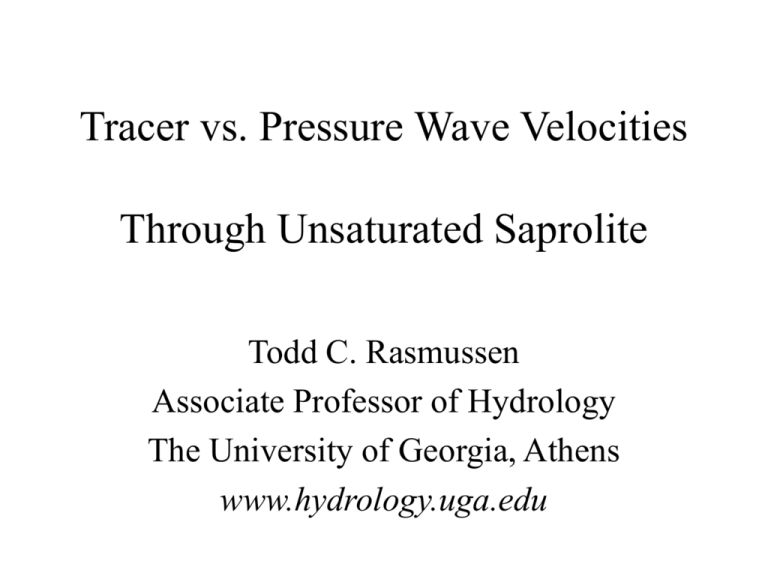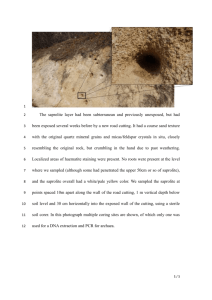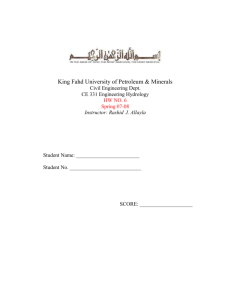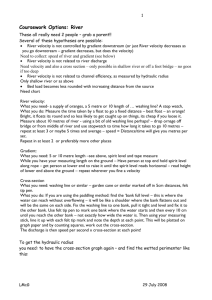Tracer vs. Pressure Wave Velocities Through Unsaturated Saprolite
advertisement

Tracer vs. Pressure Wave Velocities
Through Unsaturated Saprolite
Todd C. Rasmussen
Associate Professor of Hydrology
The University of Georgia, Athens
www.hydrology.uga.edu
Configuration for Intact Saprolite Column
Saprolite surface
TDR probe
Tensiometer
TDR probe
Suction lysimeter
TDR probe
Tensiometer
TDR probe
Suction lysimeter
TDR probe
Tensiometer
TDR probe
Ceramic plate
Depth (cm)
0
4
7
10
13
16
19
22
25
28
31
34
38
Representative Saprolite Properties
Particle sizes
sand = 0.66 g/g
silt = 0.21 g/g
clay = 0.13 g/g
Bulk density
1.25 g/cm3
Porosity
0.5283 cm3/cm3
Field saturated K
Lab saturated K
25.1 cm/day
27.3 cm/day
Chloride Tracer Responses
- Columns 1 and 2 -
1
2
z
cm
13
25
13
25
38
days
2.17
7.99
3.50
9.89
18.64
v
cm/d
6.00
3.13
3.72
2.53
2.04
ne
%
3.8
7.3
5.9
8.7
10.8
Possible Explanations for
Rapid Unsaturated Transport
•
•
•
•
•
•
Preferential flow
Bypass flow
Macropore flow
Fracture flow
Boundary layer flow
Mobile zone flow
•
•
•
•
•
Finger flow
Funnel flow
Media heterogeneities
Ion exclusion
Colloid transport
Experimental Findings
• A large saprolite core was used for an
unsaturated flow and Cl- tracer experiment
• The tracer traveled four times more quickly
than homogeneous flow predicts
• Unsaturated conditions were maintained
using short irrigation pulses, 0.6 cm3/s
• The pressure pulses traveled 1000 times
more rapidly than expected.
Irrigation Schedules
ID
Spray† Interval
sec
min
#
Duration
Flux
hours cm/day
1 A
B
5
5
40
20
9
18
6
6
0.229
2 A
B
5
5
40
20
18
29
12
9.67
0.221
†
Spray rate = 0.6 cm3/s
ID
3 A1
A2
A3
A4
A5
B1
B2
B3
B4
B5
C1
C2
C3
C4
Duration
sec
2
2
2
2
2
1
1
1
1
1
3
3
3
3
Interval #
min
10
20
30
60
120
10
20
30
60
120
20
40
60
120
6
3
2
1
1
6
3
2
1
1
3
3
1
1
Duration Flux
hours
cm/day
1
1
1
1
2
1
1
1
1
2
1
2
1
2
0.071
Types of Velocities
• Darcian flux (velocity)
– q = - K h
• Fluid (transport) velocity
–v=q/
• Kinematic (pressure wave) velocity
– c = dq / d
Unit Gradient Formulation
h = [0, 0, -1]
• Darcian flux:
q=K
• Fluid velocity:
v=K/
• Kinematic velocity:
c = dK / d
• Kinematic ratio:
k=c/v
= d (ln K) / d (ln )
Moisture Characteristic Curves
Brooks - Corey
= 0.6465 6
van Genuchten
= 0.6465 [ 1 - (1 - 7)0.1430]2
Broadbridge-White
= 52 { 1 - 1/ - ln [ (10.3 - ) / (10.3 - 1) ] / 10.3 }
where = ( - r ) / (s - r ) is the relative saturation
Advection Dispersion Equation
for Pressure Waves
•
•
•
•
is the fluid pressure head
c = dK / d is the kinematic wave velocity
D = K / Cp is the hydraulic diffusivity
Cp = d/d is the specific water capacity
Pressure Response to Spike Input
• Co is the magnitude of the input
Peak Wave Velocity
• w is the wave peak velocity
• tp is the time of peak at depth z
• = c z / D is the hydraulic Peclet Number
Effect of Hydraulic Peclet Number
• << 1 is dominated by diffusion
• >> 1 is dominated by a kinematic wave
Fluid Pressure Responses
- Column 3 z
cm
p
cm
tp
min
w
cm/d
D
cm2/d
7
17
24
34
15.28
9.91
5.94
2.35
5.08
6.75
9.42
18.17
1,983
3,627
3,670
2,695
2,314
10,276
14,680
15,272
Cp
cm-1
30.7e-6
6.9e-6
4.8e-6
4.6e-6
Conclusions
• The effective transport porosity of saprolite is
less than the total porosity
– This leads to at least a four-fold increase in the
solute velocity relative to that predicted by
homogeneous flow
• The pressure wave velocity is even faster, about
1000 times greater than the darcian flux
– A hydraulic advection-diffusion equation closely
predicts observed pressure responses
– The best fit occurs with a small specific water
capacity, Cp = d / d
Implications
• Solute Transport:
– Consistent with other studies, saprolite from the
Georgia Piedmont shows preferential solute transport
– Use of the total porosity to predict solute transport
underestimates solute travel times
• Fluid Pressure:
– Rapid pressure waves are associated with surface
perturbations
– These have attributes of displacement (piston) flow
– Use of pressure responses overestimates solute travel
times
Unsaturated Fractured Rock
Hydraulic Properties
Galileo Number
• Dimensionless number, ratio of two forces:
Hydraulic Conductivity
• The unsaturated hydraulic conductivity is:
• and the saturated hydraulic conductivity is:
• which is just the Kozeny-Carman Equation







